Some of the links in this post are affiliate links. This means if you click on the link and purchase the item, we will receive an affiliate commission from the vendor at no extra cost to you. These business relationships allow us to keep bringing you great EatMoveHack content. All opinions remain our own.
Updated 3/29/2022
Learning how to build core strength when you feel you have none can be intimidating. But we’ve got some good news for you: If you can stand up and walk, you have at least a little core strength.
Even better, there are plenty of exercises that can help beginners like you learn how to build core strength from nothing — or next to nothing, as the case may be.
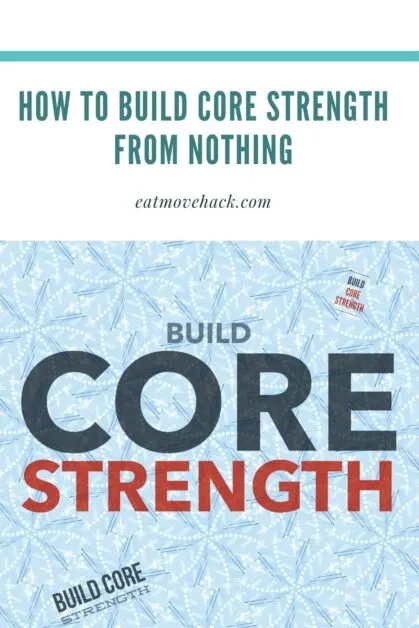
What is Core Strength?
When talking about core strength, what we’re really talking about is a large group of muscles in your lower back, hips, pelvis, and abdomen. When these muscles work together, they allow you to control your torso.
You may not realize it, but you use core muscles every day. They activate when you stand up, when you walk, and when you lift things.
Why Should You Worry About Building Core Strength?
Core strength is important for various reasons. It’s vital for better balance and stability, and it makes it easier to do lots of everyday activities, from walking long distances to lifting kids, pets, or boxes.
A strong core can also prevent the onset of back pain, while strengthening a weak core can reduce current back pain.
As you can see, there are plenty of benefits that should motivate you to do a core strength program.
Keep reading to learn more about the best core exercises to build core strength and maintain stability.
Starting with Sit-Ups
Most sit-ups are a good starter exercise for your abdominal muscles and can help you build core strength fast. You’re probably already familiar with the traditional sit-up, so we’re covering some variations that are good for building your overall core strength.
Stability Ball Sit-ups
If you have a stability ball or can use one at the gym, this core exercise is a good way of preventing back pain while doing sit-ups.
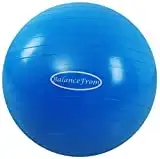
How to do stability ball sit-ups
- Start in a sitting position with your feet flat on the floor, and then slowly lean back to bring your tailbone and back to the ball.
- Adjust your legs so you feel stable and your thighs are parallel to the floor.
- Put your hands behind your neck for support, and engage your shoulder blades by squeezing them together.
- Slowly lift your upper back off the ball, and bring your chest forward.
- Once up, slowly lower yourself back onto the ball, returning to the starting position.
V-Sit-Ups
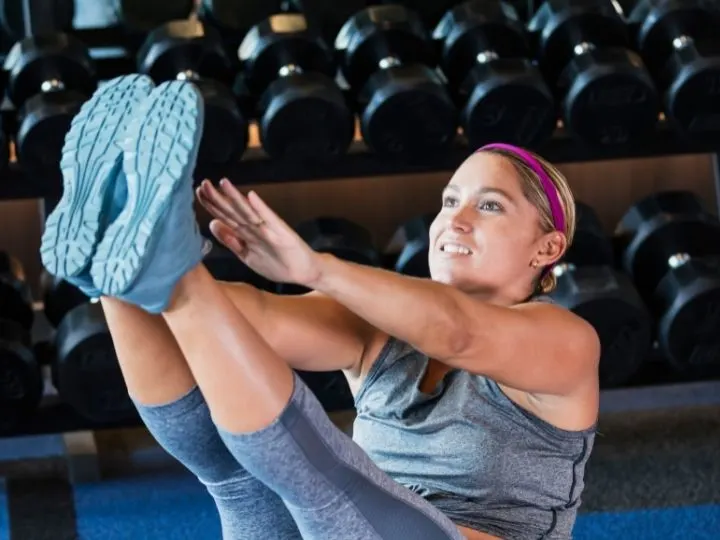
Also a great exercise for building core strength, this one might be a bit harder for beginners. You can ease into it until you feel stronger by bending your knees a little bit while holding the posture as explained below.
How to do V-sit-ups
- Start seated on the floor, and while contracting your core, slowly lift your legs up in front of you at an extended position, forming a 45-degree angle with your torso.
- Make sure your legs and torso look like a V shape, reach your arms forward towards your shins.
- Hold this position for a few seconds, and then slowly go back to a sitting position.
Butterfly Sit-Ups
This is a good variant of the classic sit-up and easy enough for all levels, but also easy to make harder, all while good for hip flexibility.
How to do butterfly sit-ups
- Start by lying on your mat, positioning the soles of your feet together, with knees bent to the side.
- Position your arms extended overhead, and then roll up your entire body until you are sitting upright. If you can, reach forward to touch your toes.
- Slowly go back to the starting position by lowering your back again.
Leg Raisers
Leg raisers are excellent for working core muscles as they require control on top of ab strength.
Classic Leg Raise
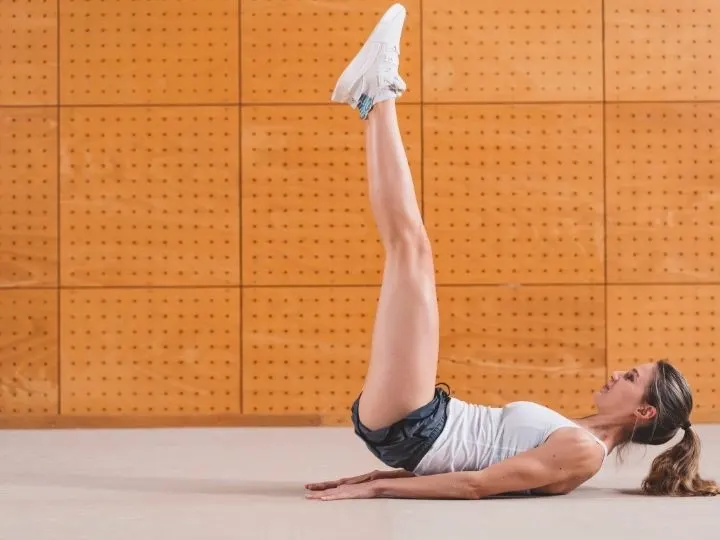
The classic leg raise targets your lower abs, but it can also improve flexibility and strength throughout your hip flexors and lower back. The key to doing this core exercise correctly is to go slow and remain in control.
How to do classic leg raises
- Lie on your back with your arms by your sides, your legs extended, and your toes pointed.
- Slowly lift your legs in a slow motion, trying to keep them straight, and aim them towards the ceiling (or as far up as you can reach).
- Hold your legs straight in this position for a few seconds, and then slowly lower them back, making sure you’re always in control of the movements.
- If you can, stop a few inches above the ground to keep tension in your muscles and start again.
Notes
Be sure you’re not losing core engagement during this exercise You should not, at any point, arch your lower back. This often is the most common mistake with this core exercise.
You can start by doing 10 reps. If this is too difficult, start with your knees bent and lift your legs that way first. Once your thighs are perpendicular to your body, try to get your legs straight to reach the ceiling.
Single-Leg Raise
This is a variation from the previous exercise. If you find classic leg raises to be too difficult, try this one-leg variation instead.
How to do single-leg raises
- Start with your left leg stretched out and your right leg with the sole of your foot on the floor and knee bent.
- Slowly lift the extended left leg, and hold the position for several seconds before returning to a neutral position.
Notes
You can do 5 reps on each leg to start with. Similar to the previous exercise, your back should not arch and your shoulder blades should stay on the floor at all times.
Supine Toe Touches
A pilates exercise, supine toe touches work your abdominal muscles to help build a stronger core. They’re good for beginners, though it may take some time to reach repeated reps.
How to do supine toe taps
- Lie on your back and raise your legs, bending your knees at a 90-degree angle and ensuring your lower legs are parallel to the floor.
- Keep your hands at your sides with palms down, and tighten your core.
- Lower your left foot until your toes nearly make contact with the ground.
- Tap the ground with your left foot, all while keeping your right leg in place in the air.
- Return your left leg back into the air, and repeat the exercise with your right foot tapping the ground.
Crunches
Crunches are popular among those who are learning how to build core strength because they specifically target the abs. When you’ve got strong abdominal muscles, you’ll also enjoy good posture and better support as a result of a neutral spine.
Wall-Abdominal Crunches
This beginner-level exercise is an effective way of building a strong core. The wall offers important support to your legs so you can focus on your deep core muscles.
How to do wall-abdominal crunches
- While lying on your back close to a wall, place your feet on the wall so that your knees and hips are positioned at 90-degree angles.
- Cross your arms on your chest to avoid straining your neck, and slowly raise your head and shoulders off the floor.
- Hold the position for 10 seconds, then slowly go back to your starting position.
Bird-Dog Crunches
This is an exercise that uses your back and abs muscles, so it’s effective for strengthening your core, but it’s also an excellent way to develop better balance.
How to do bird-dog crunches
- Start on all fours with your hands aligned with your shoulders and your knees aligned with your hips.
- Keep your core tight, and then lift and extend your right leg behind you, while at the same time extending your left arm in front of you, lifting it to shoulder level.
- Hold the position for a few seconds before moving back to the starting position.
- As you bring your left arm and right leg back to the start position, crunch your elbow to your knee, and hold again for several seconds.
- Repeat this exercise by switching to your right arm and left leg.
Oblique Seated Stretches
This is an important exercise because you can easily fit in into your day if you sit a lot. Just do a few reps while sitting in the office or in a waiting area.
How to do oblique seated stretches
- Put your feet flat on the ground, hip-width apart.
- Raise your arms above your head and form a circle with them, joining your hands.
- Keep your core engaged, and simply bend from one side to another slowly. Your back should remain straight through the entire movement.
For more crunch variations, check out our abs workouts article.
Planks
Planks are great exercises for building core stability and strength. There are also quite a few variants from the standard high plank that you can experiment with.
Side Plank
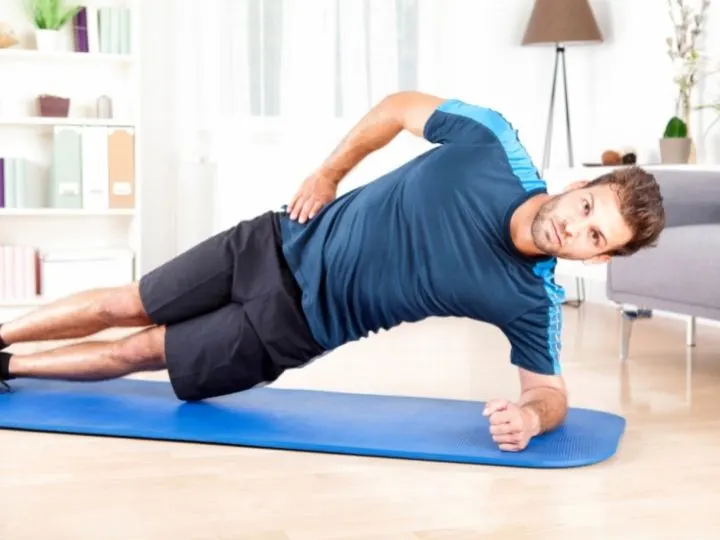
This is a good exercise for the oblique muscles and core muscles in general. As you become stronger, hold the position for longer and longer.
How to do side planks
- Put an elbow to the ground and turn your body to the left side, feet on top of each other.
- Push your body up into a straight line, with your left shoulder directly above your elbow.
- Hold the position for 20 to 30 seconds to start, and then switch sides.
Plank-Up
Plank-ups are a combination exercise, bringing together the plank and the sit-up. If you’re a beginner, take this core strengthening exercise slowly and then move faster as you build stamina and strength.
How to do plank-ups
- Start in a high plank position with your arms fully extended straight.
- Bend one arm to bring your elbow and forearm to the floor, and then do the same with the opposite arm so you are in a forearm plank position.
- Push back to the starting position by placing each hand where your elbows were.
Bridge
This is not exactly a plank exercise, but it uses similar muscles and is also a position to hold. It’s good core training for beginners, and you’ll know it’s working when you feel the burn in your core muscles.
How to do bridges
- Lie on your back, and bend your knees, positioning your feet hip-width apart.
- Make sure your feet are flat on the floor and your hands are palms down at your sides.
- Raise your hips as high as possible, aiming to have your knees, hips, and shoulders form a straight line.
- Hold the position for 20 to 30 seconds, and then slowly bring your hips and butt back down.
FAQs
What causes a weak core?
One of the most common reasons for a weak core is injury — hurting yourself seriously enough to require surgery or be bed bound is a quick way to lose strength in your core.
However, inactivity is another way to weaken your core. Sitting in a chair all day and not exercising will weaken your core muscles, and in some cases, it can lead to back pain that can make everyday life activities harder to do.
What are the best core strengthening exercises for women? And for men?
We’re often asked what are the best core exercises for women? Or what are the best core exercises for men? Well, the simple answer is that we all have the same core muscles. Targeting those muscles will be the same for men and women. So, don’t be fooled by specific core workouts for women or men.
What’s a good core workout video to follow along with?
We’re huge fans of the Alexis Ren ab workout. Her 10-minute ab workout video is a great place to start and is sure to get you a strong core in just a few weeks.
I have no core strength: What are other styles of exercise to practice for core engagement?
Many people overlook pilates and yoga when working on strength training, but these exercise routines actually focus on building stronger muscles. Because these types of exercise are low-impact, they’re perfect for the beginner who’s looking to build and strengthen their core muscles.
How long does it take to strengthen your core?
How long it takes to strengthen your core really depends on the exercises you’re doing and how often you’re doing them. Assuming a moderate routine, you can easily start to notice a stronger core in as little as 4 to 8 weeks.
Remember, you can have a strong core without visible abdominal muscles. If you want a six-pack to go along with your newfound strength, you’ll need to adjust your eating habits and work in some cardio to burn fat and reveal these muscles.
How does a strong core reduce back pain?
When you strengthen your entire core, you change the way your body carries various forces and stress. For starters, strong muscles help you maintain better posture, so you won’t be slouching or holding awkward positions. Stronger core muscles also support your body, rightfully taking the job away from your spine, which naturally relieves pressure and pain.
Wrapping Up
With this selection of core exercises, you can learn how to build your core strength. Put together a short core workout from these or integrate some of these core strength exercises into your normal workout.
Don’t forget to also think about your core strength in your daily activities, and remember to keep your core engaged when you’re cycling or simply walking. Every little bit helps when you want to strengthen your core.
Did you invest in a medicine ball to do the stability ball sit-ups? Keep working those core muscle groups with our abs and lower body medicine ball exercises.

